Research Themes
Communication System Design and Optimisation
As a key enabler for the Digital Economy, information and communication technologies (ICT) play an indispensable role in modern society. Wireless communications is a critical element in future global ICT strategy, underpinning many other industries. Videophones are commonplace and the transfer and visualisation of video data is a key component of modern business practice. Key research areas include:
- Source coding & cross-layer optimisation for low-power radio
- Large scale communication systems
- Random matrices
- Ad-hoc architectures
- Increasing the range, size and coverage of cells
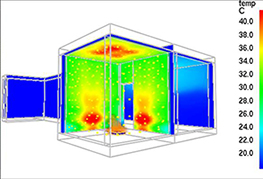 Firegrid: this example shows how we model and measure fire in buildings with robust wireless networks to assist and enhance emergency services response |
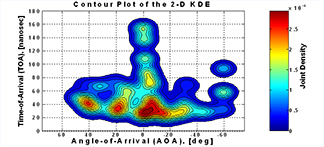 Typical Indoor channel measurement: snapshot of time and angle of arrival of observed multi-path components. |
Non linear and non Gaussian signal processing present significant research challenges, including the need to develop a unifying theory between different nonlinear processing tools, more difficult analysis and characterisation, high computational burden and the frequent inability to find a closed formulation that enables the derivation of the underlying nonlinear model. Two examples of applications in this area are the integration of wireless MIMO (Multiple Input Multiple Output) and novel waveform design and transmission techniques into the radar and sonar scenarios.
Innovative Sensing and Imaging Technologies
Within the JRI, we work extensively with conventional, still and video photographic imagery, but have very vibrant research in the development of, and processing data from, a wide variety of imaging systems, including 3D LiDAR, hyperspectral, computational photographic, radar, sonar and medical sensor data. This offers new challenges in processing data beyond 3D and in modelling the physical processes that underly such image formation.
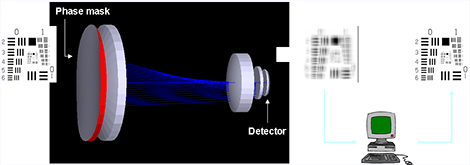 Wavefront Coding: an integrated optical and digital system leads to optimal reconstruction of images viewed through turbulent atmospheres |
 Computational photography combines computing, digital sensor design, and controlled illumination to enable novel imaging applications. One can enhance the dynamic range of the sensor, digitally vary focus, resolution, and depth of field, analyze reflectance and lighting. |
Audio, Video, Graphics and Interactive Systems
 Video imagery is a valuable tool in interpreting the world around us, allowing us to reconstruct 3D from a sequence of 2D images, and to characterise events through their characteristic motion. Increasingly, there is convergence between computer vision and graphics, and we can create mixed worlds that are a combination of real and synthetic 2D/3D imagery, most obviously in film media and games.
Video imagery is a valuable tool in interpreting the world around us, allowing us to reconstruct 3D from a sequence of 2D images, and to characterise events through their characteristic motion. Increasingly, there is convergence between computer vision and graphics, and we can create mixed worlds that are a combination of real and synthetic 2D/3D imagery, most obviously in film media and games.
Now, we are exploring the relationships between audio and video sensing, since our experience of the world in work and play is very much influenced by these two senses.
For example, environmental noise, music and acoustic reverberation often lead to unintelligible speech in crowded environments (e.g. parties), and when using audio devices such as hearing aids and mobile phones. Enhancement of a degraded or cluttered signal is an extermely important problem for many real world audio communication systems.

Autonomous and Distributive Systems
Signal and image processing are key tools to interpret, combine and plan on the basis of data from multiple sensors on mobile vehicles, for example GPS, Sonar, LiDAR, Video, Odometric and so on. Within the Institute, we have worked extensively on surface and subsea vehicles in the oceanic environment, but we have also particpated in collaborative programmes on land and in the air.
Allied to sensor interpretation for a single platform, we also consider how multiple platforms can communicate and act in concert, and how the demands on computational power can be distributed among different processors.
 Within the Ocean Systems Laboratory we apply advances in autonomous systems, sensor modelling/processing, and underwater acoustic system theory/design for offshore, marine science, renewable energy and security applications. |
 In this project with Audi, cascades of classifiers are used to identify other traffic participants as lorries, cars, cycles, pedestrians from a mobile vehicle equipped with multiple sensors. Computational resource must be selectively allocated as there is insufficent time to process all data. |
Radar, Sonar and Array Processing
Since the emergence of multiple input multiple output (MIMO) radar, we have been addressing problems in the design of correlation controlled constant amplitude MIMO waveforms and the development of adaptive receiver algorithms capable of working in environments of unknown clutter statistics and within the constraints of limited bandwidth communication channels between individual TR/RX pairs.
 |
 |
 Schematic diagram of the MIMO concept, with a Cad model and a bistatic SAR image generated using an EM modelling tool |
Another key initiative is in Compressed Sensing that can, for example, be applied to reduce sampling rates in Magnetic Resonance Imaging to the benefit of the patients:
- MRI samples lines of spatial frequency
- Each line takes time and energy & heats up the patient!
- Compressive sampling is faster, is less invasive and achieves real-time imaging
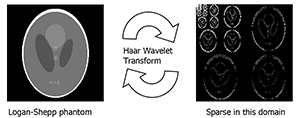 |
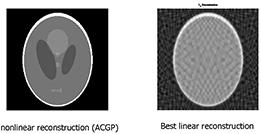 |
Tracking, Recognition and Classification
Classification and recognition are fundamental goals of signal and image analysis, whether interpreting a speech pattern in an audio signal, tracking a target signature in a radar return, or tracking and analysing the behaviour of people in CCTV camera networks.
 Tracking and analysing behaviour in the Metro: here a pedestrian is tracked as they leave the train and head for the exit. |
 The classification of objects in images requires invariance to changes in their scale, orientation, location, and in their photometry, due to varying illumination and noise. |

